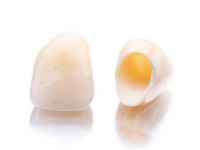Crowns & Dental Bridges
restore function, health, and appearance
Dental Crowns
A crown (or Cap) encases those missing tooth surfaces to restore normal function, contours and appearance. A crown also functions to strengthen the tooth and protect it from potential future trauma. There are various dental conditions that warrant placement of a crown. These include:
- Root canal treated teeth
- Heavily restored (large fillings) teeth
- Fractured teeth
- Teeth with extensive decay
- Esthetic considerations

A crown is created by a certified professional dental laboratory following tooth preparation and impression. The crown is then permanently bonded to the tooth. A crown can be made from a variety of materials including gold, metal and porcelain (resemble natural teeth). A crown however does not protect the tooth from future decay or gum-periodontal disease. It is thus essential to continue effective daily oral hygiene and on-going professional care to prevent tooth breakdown below the crown.
Interested in a Crown or Bridge?
Dental Bridges
Bridges represent a cemented-fixed option to replace one or more missing teeth. Although the current standard of care generally involves replacing a missing tooth with a dental implant, in specific instances, a bridge may be the most appropriate treatment option.
A bridge involves incasing teeth adjacent to the missing tooth space with crowns splinted by a prosthetic tooth, which serves to replace the missing tooth. A bridge is created by a certified professional dental laboratory following teeth preparation and impression. Once fabricated and the fit verified, the bridge is then permanently bonded to the supporting teeth. Bridges similar to crowns require meticulous oral hygiene to prolong their longevity. Long-term health requires regular professional hygiene care coupled with a customized oral hygiene regime that ensures you posses the skill set necessary to effectively clean the areas beneath your bridge (ie. floss threader).
Loved by Many


